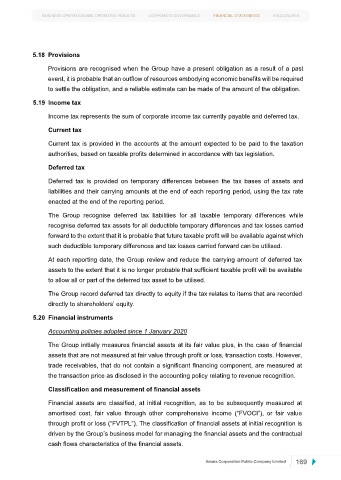Page 169 - Amata-one-report2020-en
P. 169
BUSINESS OPERATION AND OPERATING RESULTS CORPORATE GOVERNANCE FINANCIAL STATEMENTS ENCLOSURES
5.18 Provisions
Provisions are recognised when the Group have a present obligation as a result of a past
event, it is probable that an outflow of resources embodying economic benefits will be required
to settle the obligation, and a reliable estimate can be made of the amount of the obligation.
5.19 Income tax
Income tax represents the sum of corporate income tax currently payable and deferred tax.
Current tax
Current tax is provided in the accounts at the amount expected to be paid to the taxation
authorities, based on taxable profits determined in accordance with tax legislation.
Deferred tax
Deferred tax is provided on temporary differences between the tax bases of assets and
liabilities and their carrying amounts at the end of each reporting period, using the tax rate
enacted at the end of the reporting period.
The Group recognise deferred tax liabilities for all taxable temporary differences while
recognise deferred tax assets for all deductible temporary differences and tax losses carried
forward to the extent that it is probable that future taxable profit will be available against which
such deductible temporary differences and tax losses carried forward can be utilised.
At each reporting date, the Group review and reduce the carrying amount of deferred tax
assets to the extent that it is no longer probable that sufficient taxable profit will be available
to allow all or part of the deferred tax asset to be utilised.
The Group record deferred tax directly to equity if the tax relates to items that are recorded
directly to shareholders’ equity.
5.20 Financial instruments
Accounting policies adopted since 1 January 2020
The Group initially measures financial assets at its fair value plus, in the case of financial
assets that are not measured at fair value through profit or loss, transaction costs. However,
trade receivables, that do not contain a significant financing component, are measured at
the transaction price as disclosed in the accounting policy relating to revenue recognition.
Classification and measurement of financial assets
Financial assets are classified, at initial recognition, as to be subsequently measured at
amortised cost, fair value through other comprehensive income (“FVOCI”), or fair value
through profit or loss (“FVTPL”). The classification of financial assets at initial recognition is
driven by the Group’s business model for managing the financial assets and the contractual
cash flows characteristics of the financial assets.
Amata Corporation Public Company Limited 169
16

